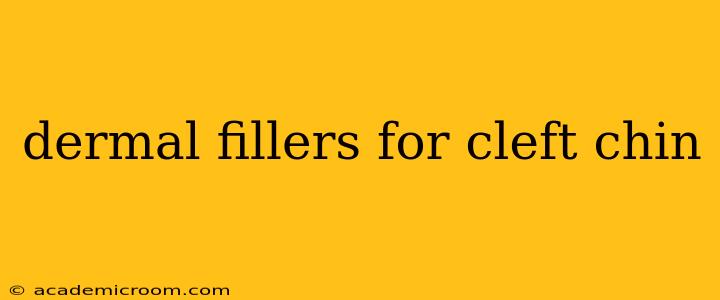A cleft chin, also known as a chin dimple or a "chin cleft," is a naturally occurring indentation in the chin. While some people embrace this unique facial feature, others may wish to minimize its appearance or enhance their chin's overall projection. Dermal fillers offer a non-surgical solution for those seeking to subtly alter the look of their cleft chin. This guide explores the use of dermal fillers for cleft chin correction, addressing common questions and concerns.
What are Dermal Fillers?
Dermal fillers are injectable substances used to add volume and fullness to various areas of the face, including the chin. They're composed of different materials, most commonly hyaluronic acid (HA), a naturally occurring substance in the body. HA fillers are temporary and eventually get absorbed, requiring repeat treatments to maintain results. Other fillers may be longer-lasting, but carry different considerations. The choice of filler depends on individual needs and the desired outcome.
Can Dermal Fillers Fill a Cleft Chin?
Yes, dermal fillers can effectively minimize the appearance of a cleft chin. By strategically injecting filler into the chin's indentation, a smoother, more projected chin profile can be achieved. The goal is not to completely eliminate the cleft but to soften its depth and create a more balanced facial harmony. The treatment is highly customizable, allowing for fine adjustments to meet individual preferences.
How is the Procedure Performed?
Before the procedure, the area is typically cleaned and numbed with a topical anesthetic. The dermatologist or plastic surgeon will then carefully inject small amounts of filler into the cleft, gradually building volume until the desired effect is achieved. The process is relatively quick and usually requires minimal downtime. Post-procedure, some minor swelling, bruising, or redness may occur, but these side effects are generally temporary.
What are the Different Types of Fillers Used?
Several types of dermal fillers are suitable for cleft chin correction, each with its unique properties and longevity. Hyaluronic acid (HA) fillers like Juvéderm and Restylane are popular choices due to their reversibility and relatively low risk of side effects. The choice of filler is crucial and should be discussed thoroughly with your doctor to determine what's best suited to your skin type, desired outcome, and budget.
What is the Recovery Time Like?
Recovery time is generally minimal. Most patients can return to their normal activities immediately following the procedure. However, mild swelling and bruising may persist for a few days. Avoid strenuous activities and excessive sun exposure in the days following the procedure to minimize the risk of complications.
How Long Do the Results Last?
The longevity of results varies depending on the type of filler used and individual factors like metabolism and skin type. HA fillers typically last for 6-12 months, requiring repeat treatments to maintain the desired effect. Longer-lasting fillers may be an option, but these should be discussed with a qualified professional to determine suitability.
Are There Any Risks or Side Effects?
As with any medical procedure, there are potential risks associated with dermal filler injections. These include bruising, swelling, redness, infection, and uneven filler distribution. Choosing a qualified and experienced injector is crucial to minimize these risks. Allergic reactions are rare, but possible, especially with certain filler types. Thorough consultation is essential before deciding on treatment.
How Much Does it Cost?
The cost of cleft chin filler treatment can vary depending on several factors, including the amount of filler used, the type of filler chosen, and the injector's fees. It's important to discuss pricing with your chosen provider before proceeding.
Are There Alternatives to Dermal Fillers?
Other options for chin augmentation include surgical chin implants or chin augmentation surgery. These options provide more permanent results but involve more significant downtime and potential risks. A consultation will help determine the best course of action for your individual needs and preferences.
By carefully weighing the pros and cons and consulting with a qualified medical professional, individuals can make informed decisions about whether dermal fillers are the right choice for minimizing the appearance of a cleft chin. Remember, realistic expectations and open communication with your practitioner are key to a successful outcome.
